|
Impact Craters throughout the Solar System
Interactive Map
of Major Impact Craters on Earth
Earth
Africa
(largest known craters)
Vredefort Crater –
Free State, South Africa
Morokweng Crater –
Kalahari Desert, South Africa
Oasis Crater –
al-Kufra, Libya
Gweni-Fada Crater –
Fada, Chad
Aorounga Crater –
Aorounga, Chad
FULL LIST OF KNOWN
IMPACT CRATERS IN
Africa
easy-to-use
Interactive Map
Asia
(largest known craters)
Popigai Crater –
Siberia, Russia
Kara Crater –
Nenetsia, Russia
Kara-Kul Crater –
Pamir Mountains, Tajikistan
Elgygytgyn Lake Crater –
Chukchi Peninsula, Russia
Zhamanshin Crater –
Irgiz, Kazakhstan
FULL LIST OF KNOWN
IMPACT CRATERS IN
Asia
easy-to-use
Interactive Map
Australasia
(largest known craters)
Acraman Crater –
South Australia, Australia
Woodleigh Crater –
Western Australia, Australia
Tookoonooka Crater –
Queensland, Australia
Yarrabubba Crater –
Western Australia, Australia
Gosses Bluff Crater –
Northern Territory, Australia
FULL LIST OF KNOWN
IMPACT CRATERS IN
Australasia
easy-to-use
Interactive Map
Europe
(largest known craters)
Lake Siljan Crater –
Dalarna, Sweden
Keurusselkä Crater –
Central Finland
Kamensk Crater –
Western Russia
Lake Lappajärvi Crater –
Lappajärvi, Finland
Boltysh Crater –
Kirovohrad Oblast, Ukraine
FULL LIST OF KNOWN
IMPACT CRATERS IN
Europe
easy-to-use
Interactive Map
North America
(largest known craters)
Sudbury Basin Crater –
Ontario, Canada
Lake Manicouagan Crater –
Quebec, Canada
Chesapeake Bay Crater –
Virginia, USA
Charlevoix Crater –
Quebec, Canada
Montagnais Crater –
Nova Scotia, Canada
FULL LIST OF KNOWN
IMPACT CRATERS IN
Canada
USA & Central America
easy-to-use
Interactive Map
South America
(largest known craters)
Chicxulub Crater –
Yucatán Peninsula, Mexico
Pantasma Crater –
Northern Nicaragua
Araguainha Crater –
Goiás/Mato Grosso, Brazil,
Iturralde Crater –
Iturralde, Bolivia
Vargeão Dome Crater –
Santa Catarina, Brazil
FULL LIST OF KNOWN
IMPACT CRATERS IN
South America
easy-to-use
Interactive Map
Earth’s Moon
FULL LIST OF KNOWN
IMPACT CRATERS ON
Earth’s Moon
Mercury
Where Lava Flowed on Mercury
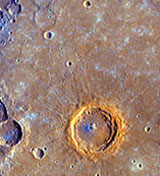
Science / AAAS
FULL LIST OF KNOWN
IMPACT CRATERS ON
Mercury
Venus
FULL LIST OF KNOWN
IMPACT CRATERS ON
Venus
Mars
Martian crater in Mamers Valles
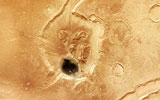
ESA
Craters and channels in Hephaestus Fossae
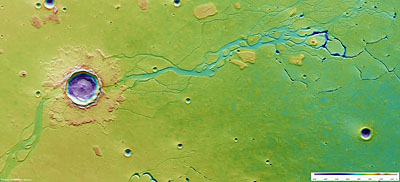
ESA
FULL LIST OF KNOWN
IMPACT CRATERS ON
Mars
Links to other sites
The Largest Impact Crater in the Solar System
Earth Impact Database
Interactive Asteroid Impact Sites Map
Impact Craters Teachers Page
Impact Craters Students Pages
Chronological List of Terrestrial Impact Craters
Do the building blocks of life travel throughout the universe on comets and on asteroids?
Below is a small selection of books suggesting that it probably does
“Life in the Universe: A Beginner’s Guide To Astrobiology”
by
Lewis Dartnell
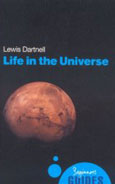
Get This Book From:
Amazon.com
Amazon.co.uk
“An excellent introduction into the newly emerging and exciting field of astrobiology. An essential, enjoyable and highly readable insight into life in its cosmic context.”
“Planets and Life: The Emerging Science of Astrobiology”
by
Woodruff T. Sullivan III
(Author, Editor)
&
John Baross
(Editor)
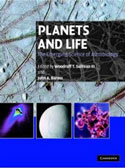
Get This Book From:
Amazon.com
Amazon.co.uk
“Astrobiology involves the study of the origin and history of life on Earth, planets and moons where life may have arisen, and the search for extraterrestrial life. It combines the sciences of biology, chemistry, palaeontology, geology, planetary physics and astronomy. This textbook brings together world experts in each of these disciplines to provide the most comprehensive coverage of the field currently available.”
“Complete Course in Astrobiology”
(Physics Textbook)
by
Gerda Horneck
(Editor)
&
Petra Rettberg
(Editor)
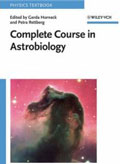
Get This Book From:
Amazon.com
Amazon.co.uk
“This up-to-date resource is based on lectures developed by experts in the relevant fields and carefully edited by the leading astrobiologists within the European community. Aimed at graduate students in physics, astronomy and biology and their lecturers, the text begins with a general introduction to astrobiology, followed by sections on basic prebiotic chemistry, extremophiles, and habitability in our solar system and beyond.”
“Astrochemistry: From Astronomy
to Astrobiology”
by
Andrew M. Shaw
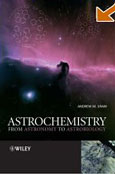
Get This Book From:
Amazon.com
Amazon.co.uk
“The dynamic field of astrochemistry brings together ideas of physics, astrophysics, biology and chemistry to the study of molecules between stars, around stars and on planets. Astrochemistry: from Astronomy to Astrobiology provides a clear and concise introduction to this rapidly evolving multidisciplinary subject. Starting with the Molecular Universe, the text covers the formation of the elements, simple models of stars and their classification. It then moves on to draw on the theme of the Origins of Life to study interstellar chemistry, meteorite and comet chemistry as well as the chemistry of planets.”
“Fitness of the Cosmos for Life: Biochemistry and Fine-Tuning”
by
John Barrow
(Editor)
Simon Conway Morris
(Editor)
Stephen Freeland
(Editor)
Charles Harper
(Editor)
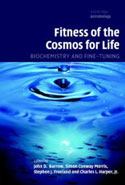
Get This Book From:
Amazon.com
Amazon.co.uk
“This highly interdisciplinary book highlights many of the ways in which chemistry plays a crucial role in making life an evolutionary possibility in the universe. Cosmologists and particle physicists have often explored how the observed laws and constants of nature lie within a narrow range that allows complexity and life to evolve and adapt. Here, these anthropic considerations are diversified in a host of new ways to identify the most sensitive features of biochemistry and astrobiology. Celebrating the classic 1913 work of Lawrence J. Henderson, The Fitness of the Environment for Life, this book looks at the delicate balance between chemistry and the ambient conditions in the universe that permit complex chemical networks and structures to exist.”
“Astrobiology: A Multi-disciplinary Approach”
by
Jonathan Lunine
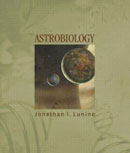
Get This Book From:
Amazon.com
Amazon.co.uk
“Astrobiology: A Multidisciplinary Approach is the most comprehensive textbook available for emerging upper-level courses in astrobiology. Internationally renowned authority Jonathan Lunine gives students with a variety of backgrounds a solid foundation in the essential concepts of physics, chemistry, biology, and other relevant sciences to help them achieve a well-rounded understanding of the fascinating study of the origin of life, planetary evolution, and life in the cosmos.”
“National Geographic Video Asteroids
Deadly Impact”
by
Mike D. Reynolds
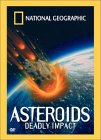
DVD Region 1
(this product requires a North American or
Multi-Region DVD Player
& NTSC compatible TV)
Available in the EU
“Asteroids and comets: Every year, millions of these “stray bullets” streak through the skies, and tons of small meteorites strike our planet! Some 65 million years ago, dinosaurs were wiped off the face of the earth – in what many believe was the aftermath of a massive cosmic collision. Could something like this happen again? Scientists believe that the impact of an asteroid only a mile wide would be globally catastrophic.”
“Comets II”
by
Michel C. Festou
H. Uwe Keller
Harold A. Weaver
(Editors)
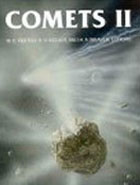
Get This Book From:
Amazon.com
Amazon.co.uk
“Comet science is a field that has seen tremendous advances in recent years, far surpassing the knowledge reflected in the original Comets volume published as part of the Space Science Series in 1982. This new volume, with more than seventy contributing authors, contains the most extensive collection of knowledge yet assembled in the field. It will enable scientists involved in their study to make connections across disciplinary boundaries and will set the stage for discovery and new understanding in the coming years.”
“Cometary Science after Hale-Bopp, Volume I”
by
Hermann Bohnhardt
Michael Combi
Mark R. Kidger
Rita Schulz
(Editors)
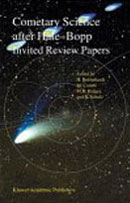
Get This Book From:
Amazon.com
Amazon.co.uk
“Comet Hale-Bopp defines a milestone event for cometary science: it is the first “really big” comet observed with modern equipment on the ground and from space and due to that; it is considered the new reference object in cometary sciences. At the beginning of a new era in spacecraft exploration of comets and five years after Hale-Bopp’s perihelion passage these proceedings of invited and contributed papers for IAU Colloquium 186 “Cometary Science after Hale-Bopp” review the state-of-the-art knowledge on comets, the icy, dusty and most primordial left-overs of the formation disk of our own solar system.”
“A Sumerian Observation of the Kofels’ Impact Event”
by
Mark Hempsell
&
Alan Bond
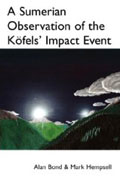
Get This Book From:
Amazon.com
Amazon.co.uk
“Around 700 BC an Assyrian scribe in the Royal Place at Nineveh made a copy of one of the most important documents in the royal collection. Two and a half thousand years later it was found by Henry Layard in the remains of the palace library. It ended up in the British Museum’s cuneiform clay tablet collection as catalogue No. K8538 (also called “the Planisphere”), where it has puzzled scholars for over a hundred and fifty years.
In this monograph Bond and Hempsell provide the first comprehensive translation of the tablet, showing it to be a contemporary Sumerian observation of an Aten asteroid over a kilometre in diameter that impacted Kofels in Austria in the early morning of 29th June 3123 BC.”
“Sites of Impact: Meteorite Craters Around the World”
by
Stan Gaz
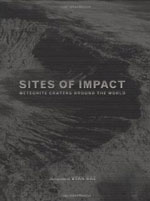
Get This Book From:
Amazon.com
Amazon.co.uk
“Meteorite Craters and Impact Structures of the Earth”
by
Paul Hodge
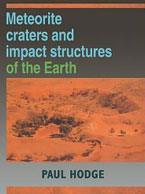
Get This Book From:
Amazon.com
Amazon.co.uk
“Impacts in Precambrian Shields”
(Impact Studies)
by
Jüri Plado
&
Lauri J. Pesonen
(Editors)
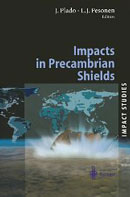
Get This Book From:
Amazon.com
Amazon.co.uk
“Meteorite Impact!
The Danger from Space and South Africa’s
Mega-Impact The
Vredefort Structure”
by
Wolf Uwe Reimold
&
Roger L. Gibson
(Authors)
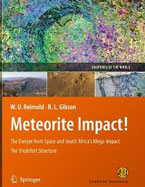
Get This Book From:
Amazon.com
Amazon.co.uk
“The Chesapeake Bay Crater: Geology and Geophysics of a Late Eocene Submarine
Impact Structure”
by
Wylie Poag
Wolf Uwe Reimold
&
Christian Koeberl
(Authors)
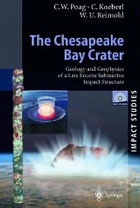
Get This Book From:
Amazon.com
Amazon.co.uk
|
|
Terrestrial & Solar System
Impacts and Impact Craters
News & New Discoveries 2006 – 2009
News & New Discoveries 2012 – 2014
News & New Discoveries 2015 – 2018
For many years academics in the historical sciences were content in their belief that terrestrial impacts by solid bodies from space was something that only happened in the very early history of our planet, whilst the average person had never heard the word ‘asteroid’. Then in 1980 the Nobel prizewinning physicist, Luis Alvarez, and his colleagues published their famous paper in “Science” which argued that a cosmic impact had led to the extinction of the dinosaurs. He showed that large amounts of the element iridium present in geological layers dating from about 65 million years BP had a cosmic origin, and proposed a radical theory that it was a massive ‘asteroid impact’ 65 million years ago which finally wiped out the dinosaurs.
Over the following decade interest began to rise in the idea of ‘terrestrial impacts’, and by 1990 most scientists at least accepted that the craters on our Moon were caused by impacts of cometary debris and asteroids of varying sizes, and not the volcanoes they had previously thought responsible.
As space exploration continued, the images sent back to Earth, especially by the Voyager spacecraft, allowed astronomers to build a picture of the sort of dynamic solar system first suggested by Victor Clube and Bill Napier in their groundbreaking books “Cosmic Serpent”, published 1982, and developed further in “Cosmic Winter” published 1990.
This was a new model of the solar system. One where regular influxes of comets from the various areas of space transitted by our solar system in its orbit through the galaxy suggested inevitable, and multiple, collisions with all the planetary bodies and their respective moons. Technologicl advances in space imaging have since shown a multitude of impact craters on all the inner planets and their moons. But some 12 years after the theories about the cosmic impact which led to the extinction of the dinosaurs were first proposed, the possibility of cometary bombardments still seemed something that belonged way back in the very early history of our solar system – even to most scientists.
It was on March 24 1993 that astronomers, husband and wife team Carolyn S. and Eugene M. Shoemaker, and David H. Levy, discovered a new comet in our solar system. Observations over the next few months determined that the comet was, at least temporarily, in orbit around Jupiter, and that on July 7 1992 the tidal forces of the largest planet in our solar system had caused the comet, by then named P/Shoemaker-Levy 9, to disintegrate. Over the next year or so astronomers on Earth
observed the fragments proceeding around the Sun and heading back on a collision course directly for Jupiter. From July 16th to 22nd 1994 they watched in awe as the 21 fragments bombarded the visible surface of Jupiter causing ‘fireballs’ 50 times the size of Earth and leaving huge scars on Jupiter’s southern hemisphere.
This was a wake-up call even for those who understood what was going on, and resulted in more funding being requested by astronomers to research the frequency of impacts throughout the solar system, but also to search for any evidence of past impacts on Earth. Following this event, there was an abrupt realisation by astonomers that if it can happen to Jupiter now, it can also happen to Earth in the future, and the search began in earnest to identify the exact orbital paths of all Earth-orbit-crossing celestial objects.
If anyone is in any doubt as to exactly how dangerous a place our planet occupies in the solar system they should simply look at our Moon. There for all to see with the naked eye, and in even greater detail using a pair of good binoculars or a small telescope, are impact craters galore. There doesn’t appear to be one square mile of the lunar surface that is not pockmarked with impact craters, and while some are undoubtedly very ancient they also contain within their crater rims a multitude of newer craters from much more recent impacts. The reason why there are so many visible craters on the Moon from ancient impacts was summed up well by astronomer, Duncan Steel, in his 1995 book,
“Rogue Asteroids and Doomsday Comets”:
“Craters are relatively swiftly eroded on Earth by rain, snow, and wind, whereas on the Moon they remain for eons until a new projectile happens to erase the scar left by some cousin countless millennia before.”
So this explains, partially, why there are so few visible craters on Earth. But raises the obvious question as to why we can’t see more given that, if our Moon is so cratered, surely our planet must be an even bigger target in the same area of the solar system? The answer is at once simple and also very complex. Firstly, there is approximately 71% of the surface area of the Earth covered with oceans – leaving just 29% dry land surface area. This gives a 3 to 1 chance that any incoming impactor will, if it doesn’t explode a few miles up like whatever happenned at Tunguska in 1908, impact one of the oceans and leave no easily visible trace.
Secondly, any crater on dry land would be at the mercy of the elements, and should there have been collisions with cometary debris, or asteroids, in the Amazon Basin, say, then vegetation would without doubt obscure them in a very short time indeed. But these are not the only factors, as Duncan Steel explained:
“The length of time that a crater will survive depends not only on the regions in which it is formed, but also on it’s size. Obviously a crater 50 kilometers across will last longer than a comparatibe pipsqueak just 100 meters in diameter. For example, in Australia there are 19 known craters – probably there are dozens more awaiting discovery – and of those, four are less than about 6,000 years old. Those are the four smallest however, all being less than 200 meters in diameter.”
At the time that Duncan Steel was writing
“Rogue Asteroids and Doomsday Comets” in 1994/1995, there were then only about 140 known terrestrial impact craters. But in the years since then, spurred on by a new-found sense of urgency following the events on Jupiter in July 1994, the search picked up steam, and many more have been discovered.
The current tally is just under 1000, and there is an interactive map of all the terrestrial impact craters accessible at the
University of Arizona website. This is an excellent resource for anyone wishing to see just how many have so far been discovered on just the 29% of the surface area of our planet that is currenly dry land.
Another good resource for information about terrestrial impact craters which also has an interactive map is accessible at the
University of New Brunswick Canadian website. The first paragraph or so of their introduction to the subject is worth quoting from here, as it puts the dynamic history of the solar system into a proper perspective:
“Until recently, impacts by extraterrestrial bodies were regarded as an interesting but, perhaps, not an important phenomenon in the spectrum of geological process affecting the Earth. Our concept of the importance of impact processes, however, has been changed radically through planetary exploration, which has shown that virtually all planetary surfaces are cratered from the impact of interplanetary bodies. It is now clear from planetary bodies that have retained portions of their earliest surfaces that impact was a dominant geologic process throughout the early solar system.
For example, the oldest lunar surfaces are literally saturated with impact craters, produced by an intense bombardment which lasted from 4.6 to approximately 3.9 billion years ago, at least a 100 times higher than the present impact flux. The Earth, as part of the solar system, experienced the same bombardment as the other planetary bodies.”
On this page we have tried to compile a photographic collection of impact craters on Earth to demonstrate just how many there actually are. Asteroids vary in their composition. Some are composed purely of stoney materials, some are composed of nickel & iron, while others have varying combinations of both. It should be understood that many of the asteroids which are made up of stoney materials do not survive the journey through our atmosphere. They explode in the upper atmosphere as the white-hot matter caused by friction upon entry hits the freezing cold air.
This has happened as recently as 1908 over the Tunguska region of Siberia, where the ‘air-burst’ caused an explosion the equivalent of many hundreds of nuclear bombs. Because the asteroid, or fragment of cometary debris, detonated in the upper atmosphere there was no impact crater to show what had happened, but many thousands of square miles of forest lands were completely flattened all around the
detonation area.
The Tunguska airburst, Siberia – June 1908
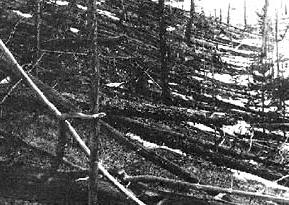
How many times has this happened before? And how soon will it be before an something like this happens again? …
“10 Greatest Major-Impact Craters on Earth”
Environmental Graffiti, USA, 17 July 2008
Click the image below or the headline above to acces this story
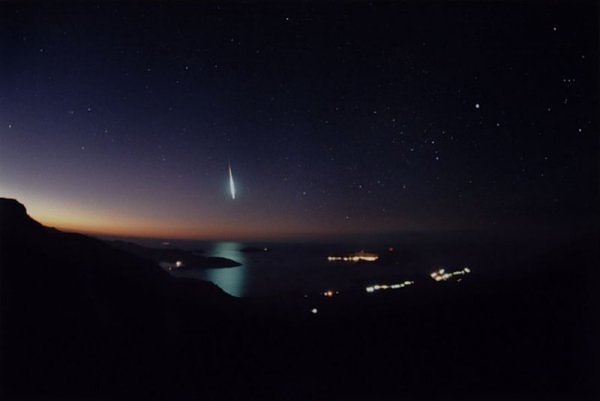
NASA
Imagine staring into the sky and seeing a tiny yellow dot, gradually getting closer. That dot doubles in size every second, until it slowly darkens the sky. You realize that this dot is actually the size of New York City and is screeching through the atmosphere faster than the speed of sound, coming right for you. This massive object will cause tsunamis, earthquakes and obliterate natural daylight for years … oh … and it will kill you.
Similar asteroid impacts have and will happen on numerous occasions in our earth’s history. Today we’ll show you the biggest impact craters by diameter.
100 Years Since The Tunguska Event
June 30, 1908

Taken during the 1927 Leonid Kulik expedition
This photograph shows trees destroyed by the blast nearly 20 years before
It has now been 100 years since the events of June 30, 1908, when a bolide of some description exploded over the Tunguska River region of Siberia. A conference to mark the anniversary took place in Moscow, Russia in 2008.
TUNGUSKA 2008 INTERNATIONAL CONFERENCE
“Tunguska: 100 years of wondering”
ABC Science News, Australia
02 July 2008
One hundred years ago, an explosion bigger than an atomic bomb blasted Tunguska, Siberia. We still don’t know what caused it, but there are plenty of theories!
In 1991, Italian scientists still found evidence of fallen trees near the blast site
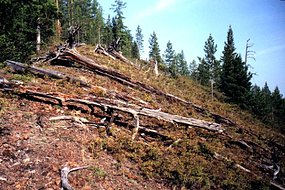
University of Bologna
Early on the morning of June 30, 1908, a massive explosion rocked the Siberian wilderness flattening more than 2,000 square kilometres of forest.
Villagers 100 kilometres away from the Podkamennaya Tunguska river basin reported seeing a fireball in the sky, feeling intense heat, hearing loud thumps and being thrown off their feet.
‘The split in the sky grew larger, and the entire Northern side was covered with fire. At that moment I became so hot that I couldn’t bear it, as if my shirt was on fire; from the northern side, where the fire was, came strong heat.’
‘I wanted to tear off my shirt and throw it down, but then the sky shut closed, and a strong thump sounded, and I was thrown a few yards’, reported one villager.
The explosion lit up the sky as far away as London for several days.
Nearly two decades later, the first expedition into the area led by Russian meteorite specialist Leonid Kulik found a region of scorched trees 50 km in diameter, but no crater.
It’s now believed that the Tunguska event — as it’s now known — was hundreds of times more powerful than the atomic bomb dropped on Hiroshima
Tunguska has long fascinated scientists, enthusiasts and sci-fi fans. Over the years, the mystery of the event has prompted a number of theories with varying degrees of scientific plausibility. These have ranged from a meteorite to the crash of an alien spacecraft; an explosion of methane or the result of Nikola Tesla’s experiments with electricity near New York.”
[Full Story]
Geographic Distribution of Known Impact Structures
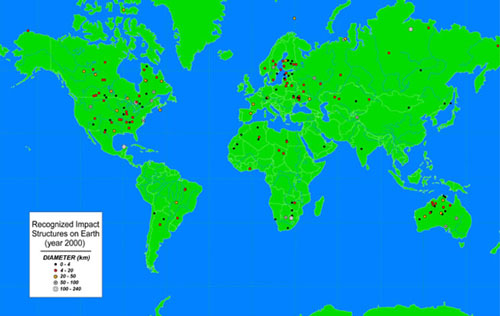
Lunar & Planetary Institute
Terrestrial & Solar System
Impacts & Impact Craters
News & New Discoveries 2010 – 2011
New Discoveries made in 2011
“Dawn Spacecraft Snaps Close-up Image
of Asteroid Vesta”
July 18, 2011, NASA Science News, USA
“NASA’s Dawn spacecraft has returned the first close-up image after beginning its orbit around the giant asteroid Vesta.
On Friday, July 15, Dawn became the first probe to enter orbit around an object in the main asteroid belt between Mars and Jupiter.
The image taken for navigation purposes shows Vesta in greater detail than ever before. When Vesta captured Dawn into its orbit, there were approximately 9,900 miles (16,000 Km.) between the spacecraft and asteroid. Engineers estimate the orbit capture took place at 10 p.m. PDT Friday, July 15 (1 a.m. EDT Saturday, July 16).
The Latest Image of Vesta Captured by Dawn
on July 16, 2011 can be accessed
HERE
Vesta is 330 miles (530 kilometers) in diameter and the second most massive object in the asteroid belt. Ground- and space-based telescopes have obtained images of Vesta for about two centuries, but they have not been able to see much detail on its surface.
‘We are beginning the study of arguably the oldest extant primordial surface in the solar system’, said Dawn principal investigator Christopher Russell from the University of California, Los Angeles.”
[Full Story]
[I have decided to include this report on this page because this is the first time that asteroid VESTA has been photographed so close up, and also because this is a “first” for exploration of Earth’s local environment in general, and NASA in particular – Ed.]
“Shoemaker Impact Structure, Western Australia”
July 18, 2011, NASA Earth Observatory, Earth Orbit
“The Shoemaker (formerly Teague) Impact Structure – located in Western Australia in a drainage basin south of the Waldburg Range – presents an other-worldly appearance in this astronaut photograph.
The Shoemaker impact site is approximately 30 kilometers (19 miles) in diameter and clearly defined by concentric ring structures formed in sedimentary rocks (brown to dark brown, image center).
An Image Of The Shoemaker (formerly Teague) Impact Structure Will Appear Here Soon
The rocks were deformed by the impact event approximately 1.63 billion years ago (as reported by the
Earth Impact Database).
Other age-dating analyses of granitic rocks at the core of the structure call this age into question (Pirajno et al. 2003).”
[Full Story]
“The scars of impacts on Mars”
March 04, 2011, ESA News, France
“ESA’s Mars Express has returned new images of an elongated impact crater in the southern hemisphere of Mars.
Located just south of the Huygens basin, it could have been carved out by a train of projectiles striking the planet at a shallow angle.
Elongated crater on Mars
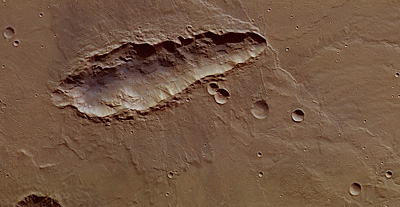
– ESA News, France
The large Huygens basin (not visible in the main image but seen in the wider contextual image) is about 450 km in diameter and lies in the heavily cratered southern highlands.
In this area there are many impact scars but none perhaps are more intriguing than the ‘elongated craters’.
Perspective view of elongated crater
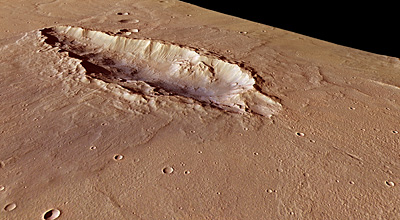
– ESA News, France
This unnamed elongated crater sits just to the south of the much larger Huygens basin. It is about 78 km in length, opens from just under 10 km wide at one end to 25 km at the other, and reaches a depth of 2 km.”
[Full Story]
“Mars Express puts craters on a pedestal”
February 04, 2011, ESA News, France
“ESA’s Mars Express has returned new views of pedestal craters in the Red Planet’s eastern Arabia Terra.
Craters are perhaps the quintessential planetary geological feature. So much so that early planetary geologists expended a lot of effort to understand them. You could say they put craters on a pedestal.
Arabia Terra on Mars
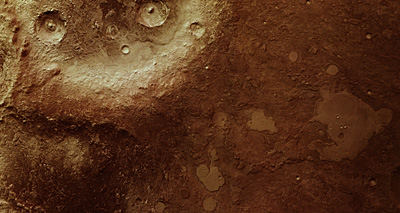
– ESA News, France
This latest image of Mars shows how the Red Planet does it in reality.
Craters are the result of impacts by asteroids, comets and meteorites. In a pedestal crater, the surrounding terrain is covered by pulverised rock thrown out of the crater. This material creates a platform or pedestal around the crater often with steep cliffs, and is usually rich in volatile materials such as water and ice.
Arabia Terra in perspective
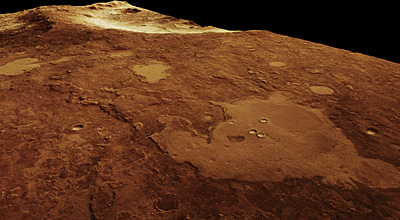
– ESA News, France
Arabia Terra is part of the highlands of Mars, stretching east to west across 4500 km in the northern hemisphere, and named for a feature drawn on Giovanni Schiaparelli’s 19th-century map of Mars.”
[Full Story]
New Discoveries made in 2010
“Wind and water have shaped Schiaparelli on Mars”
December 06, 2010, ESA News, France
“The small crater embedded in the northwestern rim of the Schiaparelli impact basin features prominently in this new image from ESA’s Mars Express. All around is evidence for past water and the great martian winds that periodically blow.
Schiaparelli is a large impact basin about 460 km in diameter located in the eastern Terra Meridiani region of the equator of Mars.
Schiaparelli on Mars
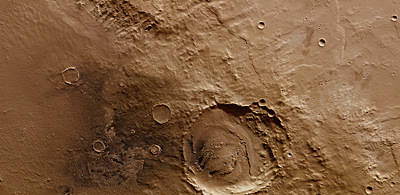
– ESA News, France
During the ‘Great Opposition’ of 1877, when Mars passed close to Earth, Schiaparelli mapped the planet, perceiving a number of straight dark lines across the red surface.
He assumed that these were natural water-filled channels and used the equivalent Italian word, ‘canali’.”
[Full Story]
“New findings posit fate of ancient Clovis people”
October 10, 2010, Arizona Daily News, USA
“Most geologists and archaeologists now believe an asteroid caused the climate change that wiped out the dinosaurs 65 million years ago.
Debate rages, however, about whether a comet abruptly killed the mammoths, saber-toothed tigers and other large animals – ‘megafauna’ – that roamed North America much more recently.
One thing is clear, say two prominent archaeologists: The mammoth hunters known as the Clovis people weren’t wiped out along with the giant mammals they hunted in a fiery comet crash 12,900 years ago.
When the mammoths disappeared, for whatever reason, the Clovis hunters found other prey, which led to adaptation of their spear tips, say Vance T. Holliday, a professor in the University of Arizona’s anthropology and geosciences departments; and David J. Meltzer, an archaeologist at Southern Methodist University”
[Full Story]
“Egyptian Desert Expedition Confirms Spectacular
Meteorite Impact”
Scientific Computing, USA, 28.09.10
“A 2008 Google Earth search led to the discovery of Kamil crater, one of the best-preserved meteorite impact sites ever found.
Earlier this year, a gritty, sand-blown expedition reached the site deep in the Egyptian desert to collect iron debris and determine the crater’s age and origins.
One day within the last several thousand years, a rare metallic meteorite travelling over 12,000 km/hour smashed into Earth’s surface near what is today the trackless border region between Egypt, Sudan and Libya.
The impact of the 1.3m, 10-ton chunk of iron generated a fireball and plume that would have been visible over 1000km away, and drilled a hole 16m deep and 45m wide into the rocky terrain.”
[Full Story]
“Massive meteor crater discovered by scientist
scanning Google Earth”
Daily Mail Online, UK, 27.09.10
“A pristine meteor crater undiscovered until it was spotted on Google Earth may help scientists determine the risks of further potentially catastrophic impacts.
The Kamil crater, which is 52 feet deep and almost 150 feet wide, is deep within the Egyptian desert, and was unknown until it was seen on Google Earth.
The crater, in southern Egypt
is one of the best preserved sites ever found
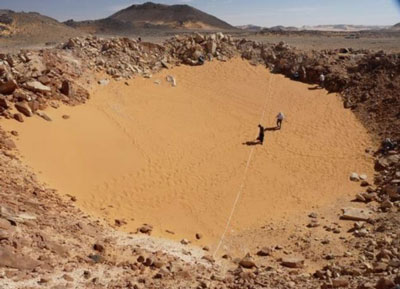
Daily Mail Online
Caused by a ten-tonne chunk of iron travelling at more than 7,500mph, it is one of the best preserved sites ever found.
The impact would have generated a fireball seen more then 620 miles away, and scientists believe it is relatively young – potentially less than a few thousand years old.”
[Full Story]
“Two large meteorite impacts
at the Cretaceous-Paleogene boundary”
Geology Magazine, USA, September 2010 Edition
“The end-Cretaceous mass extinction has been attributed by most to a single asteroid impact at Chicxulub on the Yucatán Peninsula, Mexico.
The discovery of a second smaller crater with a similar age at Boltysh in the Ukraine has raised the possibility that a shower of asteroids or comets impacted Earth close to the Cretaceous-Paleogene (K-Pg) boundary.
Here we present palynological and ?13C evidence from crater-fill sediments in the Boltysh impact crater.
Our analyses demonstrate that a post-impact flora, formed on the ejecta layer, was in turn devastated by the K-Pg event.”
[Full Story]
“Mars’s mysterious elongated crater”
ESA Mars Express News, France, August 27, 2010
“Orcus Patera is an enigmatic elliptical depression near Mars’s equator, in the eastern hemisphere of the planet.
Located between the volcanoes of Elysium Mons and Olympus Mons, its formation remains a mystery.
Orcus Patera on Mars
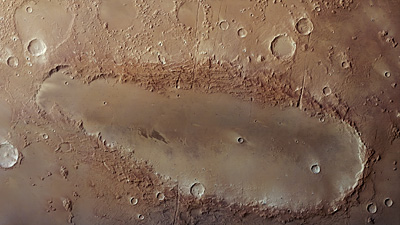
ESA
Often overlooked, this well-defined depression extends approximately 380 km by 140 km in a NNE–SSW direction.
It has a rim that rises up to 1800 m above the surrounding plains, while the floor of the depression lies 400–600 m below the surroundings.”
[Full Story]
“Jupiter Impact: Mystery of the Missing Debris”
NASA Science News, USA, June 11, 2010
“On June 3rd, 2010, something hit Jupiter. A comet or asteroid descended from the black of space, struck the planet’s cloudtops, and disintegrated, producing a flash of light so bright it was visible in backyard telescopes on Earth.
Soon, observers around the world were training their optics on the impact site, waiting to monitor the cindery cloud of debris which always seems to accompany a strike of this kind. They’re still waiting…
‘It’s as if Jupiter just swallowed the thing whole’, says Anthony Wesley of Australia, one of two amateur astronomers who recorded the initial flash. The other, Christopher Go of the Philippines, says ‘it was thrilling to see the impact, but the absence of any visible debris has got us scratching our heads.’
Indeed, it is a bit of a puzzle. ‘We’ve seen things hit Jupiter before’, says planetary scientist Glenn Orton of JPL, ‘and the flash of impact has always been followed by some kind of debris.’“
[Full Story]
“Colossal crater clue to dino disaster”
ABC Science News, Australia, June 09, 2010
“One of the big questions that has plagued humankind ever since we identified dinosaurs over a century-and-a-half ago is: ‘What on Earth killed the dinosaurs?’
Well, now we know that it wasn’t of this Earth. It’s almost certain that all non-avian dinosaurs were wiped out about 65 million years ago.
Asteroid strike on the Yucatan Peninsula
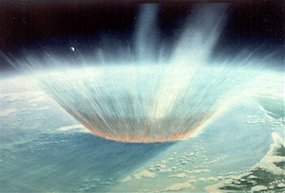
NASA Astrobiology Institute
It was a 10–15 kilometre-wide asteroid hitting the Earth, at around 50 kilometres per second. There was enough energy in that colossal impact to wipe out about 75 per cent of all species then living on Earth.
The asteroid landed on the north-east corner of the Yucatan Peninsula in Mexico, right on the Gulf of Mexico.”
[Full Story]
“Jupiter Impact Update”
SpaceWeather.com, USA, June 06, 2010
Click on the Update Link above to see images from worldwide observatories
“Jupiter collision ‘was asteroid'”
BBC Science News, UK, June 04, 2010
“An object that hit Jupiter last year with a force equivalent to a few thousand nuclear bombs, which left it with a scar the size of Pacific Ocean was probably an asteroid, say astronomers.
The spot was first seen by
an amateur Australian astronomer Anthony Wesley
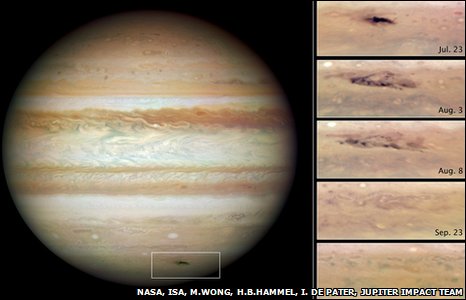
NASA Jupiter Impact Team
Images of the ‘bruise’ captured by the Hubble telescope show the aftermath of an asteroid striking a planet. It could provide clues about what might happen if a similar object hit Earth.
A team of scientists described in the Astrophysical Journal Letters how they compared the 2009 Hubble images with those of scars left on Jupiter by a comet in 1994.
Jupiter impacts were thought to be quite rare. After the latest collision with a comet called P/Shoemaker-Levy 9, or SL9, astronomers didn’t expect any other strikes for at least several hundred years.”
[Full Story]
“Impact on Jupiter
at 20:31 UT on Wednesday June 03 2010″
SpaceWeather.com, USA, June 04, 2010
“Amateur astronomers Anthony Wesley of Australia and Christopher Go of the Philippines have independently observed an impact event on Jupiter. The strike occurred at 20:31 UT on June 3rd and produced a bright flash of light in the giant planet’s cloudtops:
Click on the image below by Anthony Wesley in Australia
to see the video made by Christopher Go in the Philippines
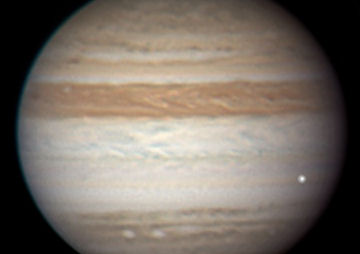
Anthony Wesley, Broken Hill Australia
‘I still can’t believe that I caught a live impact on Jupiter’ Go, who made the video, told Spaceweather.com. ‘There were no visible remains at the impact point for the next half hour or so, until sunrise put an end to the imaging’ says Wesley who took the photo above.
On August 03 2009 the NASA Science News website reported details of an impact on Jupiter a couple of weeks earier on July 19 2009.
While in July 1994 the fragmented Comet Shoemaker-Levy 9 impacted Jupiter. It was described by Wikipedia as ‘the first direct observation of an extraterrestrial collision of solar system objects’.
Anthony Wesley has also posted a 24 second video of the impact event on his webpage”
[Full Story at SpaceWeather.com on June 04 2010]
“Fireball found: Chunk of huge meteor that exploded over Wisconsin located”
Christian Science Monitor, USA, May 11, 2010
“The largest chunk yet of a meteor that exploded over Wisconsin last month has been found by intrepid space rock hunters.
But the remnant, which broke into three pieces after hitting the ground, is still small enough to fit in the palm of your hand.
Ruben Garcia holds a 21-gram meteorite found by a member of his group, April 20, 2010 in Iowa County near Livingston, Wisconsin
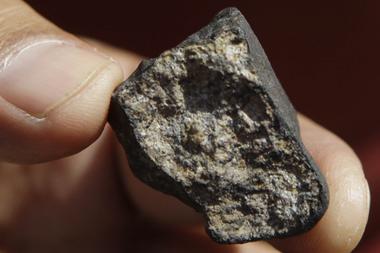
Mark Hoffman/Milwaukee Journal Sentinel/MCT/Newscom
Marvin Killgore, the curator of meteorites for the Lunar and Planetary Laboratory at the University of Arizona, and his wife, Kitty, arrived in Mineral Point, Wisc., just days after the April 14 fireball sighting, and now have a 10.6-ounce (300-gram) chunk of space rock that may be the largest piece of the meteor found so far.
On April 14, people in southwestern Wisconsin and northern Iowa bore witness to a sonic boom and fireball that briefly lit up the late evening sky.
The object, an ancient rock from space, entered the Earth’s atmosphere as a ball of flames after a 4.5 billion year journey through the solar system.”
[Full Story]
“Bright green Midwestern meteor fragments
over Wisconsin, USA”
SpaceWeather.com, USA, April 15, 2010
“Sky watchers in Minnesota, Wisconsin, Iowa, Illinois and Missouri witnessed a brilliant green fireball streaking across the sky.
The fireball was caused by a small asteroid hitting Earth’s atmosphere at a shallow angle.
Images from a rooftop webcam in Madison, Wisconsin
show a brilliant midair explosion:
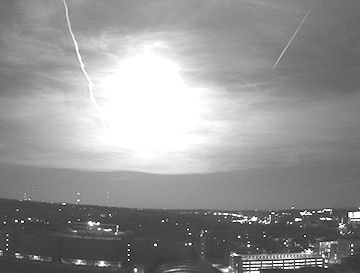
University of Wisconsin – AOS/SSEC
Preliminary infrasound measurements place the energy of the blast at 20 tons of TNT (0.02 kton), with considerable uncertainty.
Bill Cooke of NASA’s Meteoroid Environment Office estimates that the space rock was about 1 meter wide and massed some 1260 kg.
There are a number of news reports, including videos, from around the Midwestern USA, that you can access by clicking on these links.”
[Full Story]
“Did a comet trigger a mini Ice Age?”
Cosmos Magazine, Australia, April 05, 2010
“A sudden plunge of global temperatures at the dawn of human civilisation may have been caused by a comet impact, a British researcher argues.
Known as ‘the Younger Dryas’, it has been also called the Big Freeze and the Last Blast of the Ice Age – but for researchers trying to understand the Earth’s ancient climate, it’s one of the big mysteries of the field.
A sudden plunge of global temperatures 12,900 years ago may have been caused by a comet impact, a British researcher argues
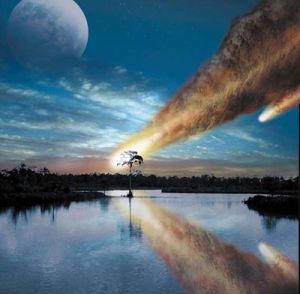
U.S. Geological Survey / Cosmos Magazine
Around 12,900 years ago, Earth was on a steadily warming trend after almost 100,000 years of harsh glaciation, during which ice sheets placed a swathe of the northern hemisphere under a dead hand, extending their thrall as far as south as New England and Wales.
But just as the glaciers were beginning to retreat, and an easier life at last beckoned for Earth’s tiny population of humans, everything went into reverse.
Temperatures fell dramatically by up to 8?C, heralding a cruel winter that would last 1,300 years. But what caused it?
Crunching powerful equations and weighing fresh evidence, an astrobiologist in Britain is pointing the finger at an unusual culprit.
Earth collided with debris from a vast comet, measuring 50 to 100 km across, that had wandered into the inner Solar System some 30,000 years ago before breaking up, says Bill Napier, a professor at Cardiff University’s Astrobiology Centre.”
[Full Story]
“DR Congo ring may be giant ‘impact crater'”
The Montreal Gazette, Canada, March 06, 2010
Deforestation has revealed what could be a giant impact crater in Central Africa, scientists say
“The 36-46km-wide feature, identified in DR Congo, may be one of the largest such structures discovered in the last decade.
A survey in the area is now required to stand up some of the ideas
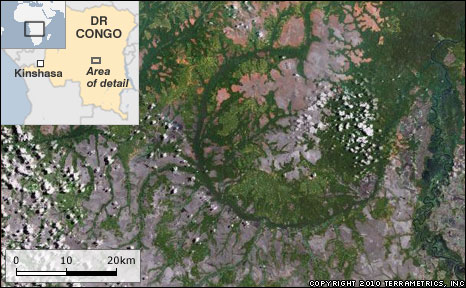
TerraMetrics Inc. / BBC News
Italian researchers considered other origins for the ring, but say these are unlikely. They presented their findings at the recent Lunar and Planetary Science Conference in Texas, US.
The ring shape is clearly visible in the satellite image by TerraMetrics Inc reproduced on this page.
Only about 25 terrestrial impact craters are of comparable size or larger, according to the web-based Earth Impact Database.
The putative crater lacks a well-defined outer ridge, though the University of Padova team says this could be explained by deep weathering and erosion in the tropical climate.”
[Full Story]
“Microbe traces hint at life on Mars”
The Montreal Gazette, Canada, March 06, 2010
Key role in evolution on earth. Study of Arctic crater at ancient meteorite crash site points to bacterial activities
“Scientists studying an ancient meteorite crash site in the Canadian Arctic have detected traces of microbes that point to the key role played by impact craters in the evolution of life on Earth and could help determine whether life once existed on Mars.
The discovery – hailed by an 11-member team of researchers from Canada, Britain, the U.S. and Sweden as a scientific ‘first’ – was made at Devon Island’s famous Haughton Crater, a uniquely dry and desolate geological gem probed frequently by experts from NASA because of its Mars-like features.
‘Meteorite impact craters have been proposed as possible sites to find microbial life on Mars, as they are a focus for heat and water circulation’, the research team, including University of Western Ontario geologist Gordon Osinski, state in a summary of their findings.
The researchers examined meteorite-shocked rocks from numerous sites throughout the 24-kilometre-wide crater and found telltale traces of sulphur left behind by heat-loving, ‘thermophilic’ bacteria that moved into the crash site following the impact.”
[Full Story]
“Crater-in-a-crater may offer peek at moon guts”
MSNBC News, USA, March 05, 2010
“A big crater inside a huge crater on the moon could offer a view of the lunar innards, scientists now say.
Here’s the setup: Shortly after the moon formed, it got whacked, big time. The result, an enormous crater called the South Pole-Aitken basin.
It’s almost 1,500 miles across and more than five miles deep.
The impact punched into the layers of the lunar crust, scattering that material across the moon and into space.
The tremendous heat of the impact also melted part of the floor of the crater, turning it into a sea of molten rock.
‘This is the biggest, deepest crater on the moon — an abyss that could engulf the United States from the East Coast through Texas’, exlained Noah Petro of NASA’s Goddard Space Flight Center.”
[Full Story]
“Dinosaur extinction link to crater confirmed”
BBC News, UK, March 04, 2010
“An international panel of experts has strongly endorsed evidence that a space impact was behind the mass extinction event that killed off the dinosaurs. They reached the consensus after conducting the most wide-ranging analysis yet of the evidence.
The dinosaurs were one of many groups to go extinct
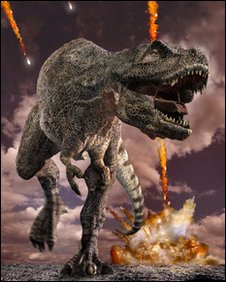
BBC News
Writing in Science journal, they rule out alternative theories such as large-scale volcanism.
The analysis has been discussed at the 41st Lunar and Planetary Science Conference (LPSC) in the US.
Today, the crater is buried under Mexico’s Yucatan Peninsula
but weaknesses in the overlying rock have produced
a ring of slumping that is visible from space
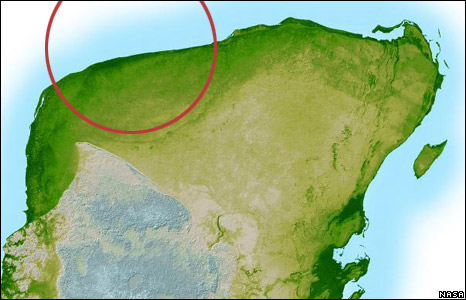
NASA / BBC News
The extinction wiped out more than half of all species on the planet, including the dinosaurs, bird-like pterosaurs and large marine reptiles, clearing the way around 65 million years ago for mammals to become the dominant species on Earth.
Their review of the evidence shows that the extinction was caused by a massive asteroid or comet smashing into Earth at Chicxulub on Mexico’s Yucatan Peninsula.
The huge crater that remains from the event is some 180km in diameter and surrounded by a circular fault about 240km in diameter.”
[Full Story]
“It’s official: An asteroid wiped out the dinosaurs”
Yahoo News / Reuters, USA, March 04, 2010
“A giant asteroid smashing into Earth is the only plausible explanation for the extinction of the dinosaurs, a global scientific team said on Thursday, hoping to settle a row that has divided experts for decades.
A panel of 41 scientists from across the world reviewed 20 years’ worth of research to try to confirm the cause of the so-called Cretaceous-Tertiary (KT) extinction, which created a ‘hellish environment’ around 65 million yrs ago and wiped out more than half of all species on the planet
Skeleton of a dinosaur is pictured on display at a Tokyo museum.
Dinosaurs were wiped out by a huge asteroid …
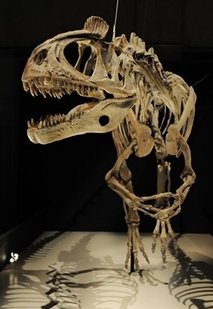
AFP / Yahoo News
Scientific opinion was split over whether the extinction was caused by an asteroid or by volcanic activity in the Deccan Traps in what is now India, where there were a series of super volcanic eruptions that lasted around 1.5 million years.
The new study, conducted by scientists from Europe, the United States, Mexico, Canada and Japan and published in the journal Science, found that a 15-kilometre (9 miles) wide asteroid slamming into Earth at Chicxulub in what is now Mexico was the culprit.
The asteroid is thought to have hit Earth with a force a billion times more powerful than the atomic bomb at Hiroshima.”
[Full Story]
“Clues to Antarctica space blast”
BBC News, UK, March 03, 2010
“A large space rock may have exploded over Antarctica thousands of years ago, showering a large area with debris, according to new research.
The evidence comes from accumulations of tiny meteoritic particles and a layer of extraterrestrial dust found in Antarctic ice cores.
The team’s findings could help in the search
for other ancient ‘airbursts’
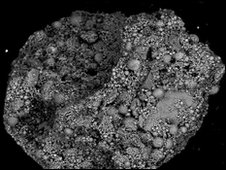
BBC News
Details of the work were presented at a major science conference in Texas.
The event would have been similar to the Tunguska event, which flattened a large area of Siberian forest in 1908.
It is thought to have been a so-called ‘airburst’ in which a space rock does not reach the ground, but rather explodes in the atmosphere.”
[Full Story]
“Saving Earth one Asteroid at a time”
The Planetary Society, USA, February 12, 2010
“Last month, a baseball-sized meteorite punched through the roof of a doctor’s office in Lorton, Virginia, scattering insulation and ripping a hole in the carpet. What if it had been larger – much larger – and what if we knew in advance that it was coming?
This month, The Planetary Society calls attention to the dangers our planet faces from near-Earth objects (NEOs) through announcement of the discovery of South America’s largest known impact crater by a researcher funded by a Planetary Society grant, participation in a meeting in Vienna of the United Nations Action Team-14, and publication of a special issue of The Planetary Report on planetary defense.
Max Rocca, based in Buenos Aires, Argentina, applied for a Planetary Society grant to help fund his search for impact craters in South America.
In 2008, Rocca made contact with a group of geologists at the National University in Bogota, Colombia, who were studying the Vichada River region on behalf of mining companies.
In cooperation with a colleague at Ohio State University, they examined the gravitational anomalies over the Vichada structure, confirming that Rocca’s discovery was indeed an impact crater — the largest in South America, 50 kilometers in diameter.”
[Full Story]
“Craters young and old in Sirenum Fossae”
ESA News, France, February 03, 2010
“The Mars Express High Resolution Stereo Camera has imaged craters both young and old in this view of the Southern Highlands of Mars.
Part of the Sirenum Fossae region in the Southern Highlands, the area in this image is centred at about 28°S / 185°E.
Part of the Sirenum Fossae region in the
Southern Highlands of Mars
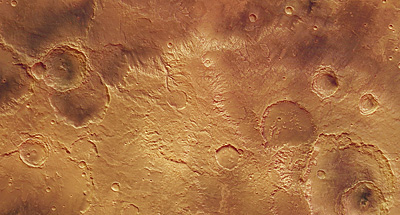
ESA News
The image captures an area to the north of the Magelhaens Crater. It extends some 230 km by 127 km and covers about 29 450 sq km, roughly the size of Belgium. The image resolution is approximately 29 metres per pixel.
Sirenum Fossae extends for more than 2500 km to the southwest of the Tharsis volcanic region, which contains Olympus Mons, the highest volcano in our Solar System.
Sirenum Fossae is a system of grabens, formed by stresses placed on the crust during the uprising of the Tharsis region. A graben is visible as two sets of parallel lines running from top to bottom to the left of centre.”
[Full Story]
“Fears of cataclysm prompt more research into asteroids”
Ethiopian Review, Ethiopia, February 01, 2010
“There is a growing consensus among the global scientific community that the planet is under threat.
The danger they warn of is by no means a new one; in fact it is the same one that many hypothesize led to the extinction of the dinosaurs approximately 65 million years ago – asteroids.
Every year more of these clusters of metal, ice, and rock hurtling through space are observed by astronomers.
From its operations center in Darmstadt, the European Space Agency (ESA) is deeply involved in researching asteroids and has been cooking up a cosmic caper to pay one a visit for the better part of a decade. But why all the fuss?
According to US space agency NASA, the Solar System is host to more than one million of these so-called Near Earth Objects (NEOs), a term that includes comets and asteroids, that are greater than 40 meters in diameter, considered the threshold size for them to penetrate the Earth’s atmosphere.
NASA is also tracking more than 1,100 asteroids at least two kilometers in diameter.
On December 30, Anatoly Perminov, chief of Russia’s Space Agency, Roscosmos, told Russian media that the agency was drawing up plans to prevent a collision between an asteroid known as 99942/Apophis and the Earth.
Apophis, measuring approximately 270 meters in diameter, regularly passes through the Earth’s orbit on its own elliptical trip around the Sun.
Apophis made waves in the scientific community when first discovered because it was initially believed that the asteroid would collide with the Earth on Friday the 13th of April, 2029.
After further study of the object’s orbit, it was determined that it would not collide with the Earth, but would still pass extremely close, within the outer ring of satellites used to transmit television signals.”
[Full Story]
“Chiyli Crater, Kazakhstan”
Earth Obervatory, Earth Orbit, January 31, 2010
“In the grasslands of western Kazakhstan, roughly 320 kilometers (200 miles) north-northeast of the Aral Sea, lies Chiyli Crater.
From the perspective of a satellite, the crater is subtle but discernible—concentric rings in the arid landscape, evidence of an extraterrestrial object crashing into our planet millions of years ago.
Chiyli Crater, Kazakhstan
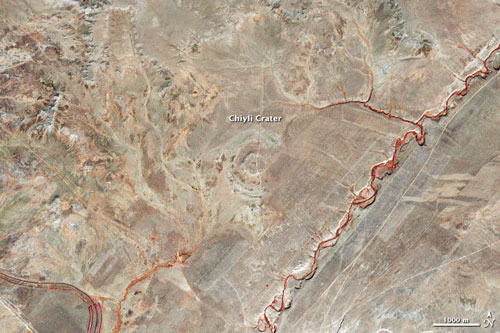
NASA Earth Observatory
The Advanced Spaceborne Thermal Emission and Reflection Radiometer ‘(ASTER)’ on NASA’s Terra satellite captured this false-color image of Chiyli Crater on October 10, 2007.
Vegetation appears red, water appears blue, and land with few or no growing plants appears in earth tones.
Waterways contrast with their surroundings due primarily to the vegetation clinging to their riverbanks, especially the river southeast of the crater.”
[Full Story]
Terrestrial & Solar System
Impacts and Impact Craters
News & New Discoveries 2010 – 2011
News & New Discoveries 2012 – 2014
News & New Discoveries 2015 – 2018
|
|
Below are some images of the larger known asteroids
Asteroid Eros
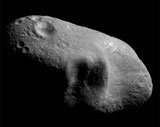
NEAR, JHU APL, NASA
“Several spacecraft have orbited or landed on asteroids and sent pictures of these bodies back to Earth. The NEAR Shoemaker mission, launched in 1996, was the first spacecraft to land on an asteroid, touching down on Eros on February 12, 2001.”
Asteroid 253 Mathilde
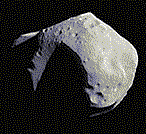
NEAR, JHU APL, NASA
On June 27, the NEAR (for Near Earth Asteroid Rendezvous) spacecraft, traveling some 36,000 kilometers per hour, streaked past an asteroid named Mathilde far beyond the orbit of Mars. It was just a brief encounter along a long journey to a different asteroid, Eros.
Asteroid Ida
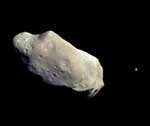
copyright © 2002 NEAR, JHU APL, NASA
“Liquid water, carbon-based molecules and a relatively stable environment are critical elements for life. Comets and asteroids can bring water and the chemicals on which life is based, but can also bring widespread destruction. If future impacts are inevitable, what should we do?”
Books About Asteroids,
Comets, Meteor Storms,
Impact Craters & Ancient Cosmic Catastrophes

“A Sumerian Observation of the Kofels’ Impact Event”
by
Mark Hempsell
&
Alan Bond

Get This Book From:
Amazon.com
Amazon.co.uk
“Around 700 BC an Assyrian scribe in the Royal Place at Nineveh made a copy of one of the most important documents in the royal collection. Two and a half thousand years later it was found by Henry Layard in the remains of the palace library. It ended up in the British Museum’s cuneiform clay tablet collection as catalogue No. K8538 (also called “the Planisphere”), where it has puzzled scholars for over a hundred and fifty years. In this monograph Bond and Hempsell provide the first comprehensive translation of the tablet, showing it to be a contemporary Sumerian observation of an Aten asteroid over a kilometre in diameter that impacted Kofels in Austria in the early morning of 29th June 3123 BC.”
“The Chesapeake Bay Crater: Geology and Geophysics of a Late Eocene Submarine Impact Structure”
by
Wylie Poag
Wolf Uwe Reimold
&
Christian Koeberl
(Authors)

Get This Book From:
Amazon.com
Amazon.co.uk
“This volume synthesizes 16 years of geological and geophysical studies which document an 85-km-wide impact crater buried 500 m beneath Chesapeake Bay in south eastern Virginia, USA. The authors integrate extensive seismic reflection profiling and deep core drilling to analyze the structure, morphology, gravimetrics, sedimentology, petrology, geochemistry, and paleontology of this submarine structure. Of special interest are a detailed comparison with other terrestrial and extraterrestrial craters, as well as a conceptual model and computer simulation of the impact. The extensive illustrations encompass more than 150 line drawings and core photographs. An accompanying CD-ROM includes selected seismic profiles, scaled cross sections, detailed maps, and downhole geophysical logs.”
“Bombarded Britain: A Search for British Impact Structures”
by
Richard Stratford
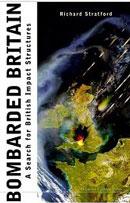
Get This Book From:
Amazon.com
Amazon.co.uk
“Describes a search for geological evidence of meteorite impact structures in Britain. The statistics of impact structures indicate that Britain should have Phanerozoic impact structures up to tens of kilometres in diameter. A constant theme is the importance of atmospheric break-up of small asteroids and comets. These fragmenting bodies produce anomalously shallow craters with low rims and central peaks; three British structures of this type are identified. Analysis of fireball statistics implies that damaging fireball explosions occur over the British Isles on a time-scale of decades. On a time-scale of millennia, however, more damage is done by Atlantic impact tsunami.”
“The Big Splat, or How Our Moon Came to Be: A Violent
Natural History”
by
Dana Mackenzie
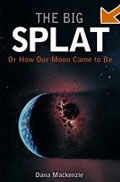
Get This Book From:
Amazon.com
Amazon.co.uk
“Mackenzie prefaces his absorbing account of the new “giant impact” theory of the moon’s origin with the fascinating story of humanity’s long relationship with Earth’s only natural satellite. Evidence of that relationship begins with what is very probably a lunar calendar among the famous Lascaux cave paintings, and continues in early civilizations’ timekeeping uses of the moon and classical Greek ideas about the moon’s composition. In the fifth century B.C.E., Anaxagoras correctly realized that the moon was made of rock. Later, Aristotle didn’t agree, and his view held sway for centuries.”
“Impact Tectonics”
by
C. Koeberl
(Editor)
&
Herbert Henkel
(Editor)
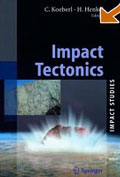
Get This Book From:
Amazon.com
Amazon.co.uk
“This volume is the 8th in a series of impact books resulting from the activities of the scientific program “Response of the Earth System to Impact Processes” (IMPACT), by the European Science Foundation. The book resulted from an international meeting at Mora, Sweden, which was held as part of the IMPACT program. The papers cover various structural geologic, geochemical, and geophysical topics on research of asteroid impact structures on Earth and Mars.”
“The Cambridge Encyclopedia
of Meteorites”
by
O. Richard Norton
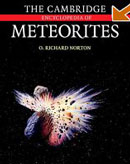
Get This Book From:
Amazon.com
Amazon.co.uk
“In recent years, meteorites have caught the imagination of scientist and collector alike. An army of people are now actively searching for them in the hot and cold deserts of Earth. Fascinating extraterrestrial rocks in meteorites are our only contact with materials from beyond the Earth-Moon system.”
“The Celtic Gods:
Comets in Irish Mythology”
by
Mike Baillie
&
Patrick McCafferty
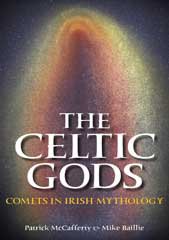
Get This Book From:
Amazon.com
Amazon.co.uk
“The Celtic myths, involving heroic warriors such as Finn and CuChulinn, can be read as simple primitive stories, but closer examination reveals strange descriptions and relationships.
The authors of this ground-breaking book argue that all the principal characters are aspects of the one Celtic sky god, Lugh, who was a comet. Against the background of a comet scenario this re-interpretation of about ten key Celtic myths shows how many of the descriptions in the myths fit the appearance of comets.
The fact that these comets on occasions produced abrupt environmental changes, that can be traced in the tree-ring and ice-core chronologies, pins the stories to a central reality. With a novel twist this original book confirms the widespread belief that these stories must contain a ‘core of truth’.”
“Rogue Asteroids and
Doomsday Comets
by
Duncan Steel
(Author)
Arthur C. Clarke
(Foreword)

Get This Book From:
Amazon.com
Amazon.co.uk
“Could both Stonehenge and the pyramids of Egypt have been constructed to observe and commemorate a period of phenomenal meteor storms and asteroid detonations produced by a burst of activity in the Taurid Complex 4,500 to 5,000 years ago? Author Duncan Steel examines the evidence indicating rogue asteroids and doomsday comets may have been behind these and other ancient phenomena.”
“The End of the Dinosaurs:
Chicxulub Crater and
Mass Extinctions”
by
Charles Frankel
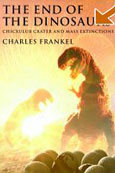
Get This Book From:
Amazon.com
Amazon.co.uk
“The End of the Dinosaurs gives a detailed account of the great mass extinction that rocked the Earth 65 million years ago, and focuses on the discovery of the culprit: the Chicxulub impact crater in Mexico. It recounts the birth of the cosmic hypothesis, the controversy that preceded its acceptance, the search for the crater, its discovery and ongoing exploration, and the effect of the giant impact on the biosphere. Other mass extinctions in the fossil record are reviewed, as is the threat of asteroids and comets to our planet today. The account of the impact and its aftermath is suitable for general readers. The description of the crater geology is in enough detail to interest students of the earth sciences. A detailed index and bibliography are included.”
“Meteorite Craters and Impact Structures of the Earth”
by
Paul Hodge

Get This Book From:
Amazon.com
Amazon.co.uk
“During its five billion year history, Earth has been hit countless times by asteroids and meteorites. Over 150 crater-producing events have been identified, and this book describes all 139 sites worldwide at which evidence of the impacts can be seen. They range in age from recent craters formed this century to the highly eroded billion-year old ancient craters. Some are spectacular to visit, such as the Barringer Crater in Arizona, the ring-shaped mountains of Gosses Bluff, Australia, and the huge crater at Ries in Germany.
For each site there is a summary table giving location, size, age and present condition. Maps are included where necessary. The author has visited many of the sites and his photographs enrich this thorough survey. Meteorite craters are fascinating to visit, so the descriptions include guidance about access and suggested itineraries for the large structures.”
“Meteorite Hunter: The Search
for Siberian Meteorite Craters”
by
Roy A. Gallant

Get This Book From:
Amazon.com
Amazon.co.uk
“On the morning of June 30, 1908, a fireball cascaded down the Siberian sky and exploded with 2000 times the force of the nuclear blast that devastated Hiroshima, Japan. Weighing some 100,000 metric tons, the cosmic missile cut into the atmosphere and shattered in a rapid series of bursts, felling trees and incinerating an area of 2150 square miles – now known as the Tunguska ‘event’.
In the spring of 1992, Roy Gallant was invited by the Siberian branch of the National Academy of Sciences to take part in the annual Tunguska Expedition, to investigate this largest meteorite explosion in human history.”
“Meteorite Craters”
by
Kathleen Mark
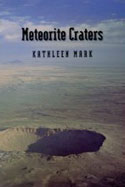
Get This Book From:
Amazon.com
Amazon.co.uk
“In the early years of the twentieth century, an enormous bowl-shaped hole in the high plains of northern Arizona was investigated by a mining engineer and his associates. The hole was almost three quarters of a mile wide-a little over one kilometer¹-and it penetrated thick layers of subsurface rock.
The investigators concluded that it was created thousands of years ago when a mass of meteoritic iron struck the earth, and they produced extensive evidence in support of their claim.”
“Rocks from Space: Meteorites
and Meteorite Hunters”
by
O. Richard Norton
&
Dorothy S. Norton
(Illustrator)

Get This Book From:
Amazon.com
Amazon.co.uk
“Norton (astronomy, Central Oregon Community College) tells the story of meteorites and our attempts to read their history. Topics include the development of the interdisciplinary science of meteoritics, asteroids, current classifications of meteorites, and the impact of the comet Shoemaker-Levy on Jupiter in 1994.
“Falling Stars: A Guide to
Meteors and Meteorites”
by
Mike D. Reynolds
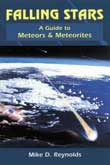
Get This Book From:
Amazon.com
Amazon.co.uk
“A straightforward, thorough look at all aspects of meteors and meteorites, including how and where meteors originate, when and where to watch for them, and how to classify, collect, and preserve meteorites. Meteor showers, interesting meteorite craters, and tektites are all discussed in detail. Also contains a comprehensive listing of meteorite organisations, dealers, museums, and references.”
|
























































